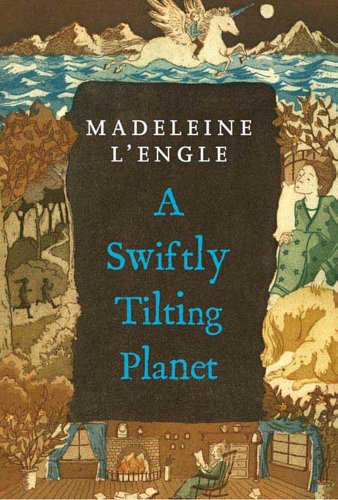
![]() A Swiftly Tilting Planet by Madeleine L’Engle
A Swiftly Tilting Planet by Madeleine L’Engle
A Swiftly Tilting Planet (1978) is the third book in Madeleine L’Engle’s TIME quintet, a series of science fiction novels for children. The first book, the Newbery Medal-winning A Wrinkle in Time, blew my mind when I was a kid and I’m just now getting around to reading the sequels.
In A Swiftly Tilting Planet, Meg Murray is now an adult. She’s married to her childhood friend Calvin O’Keefe and is pregnant with their first child. It’s Thanksgiving time and Calvin is away at an academic conference overseas. Calvin’s mother, a strange reclusive woman who has never shown any interest in the Murray family, has unexpectedly accepted their invitation to Thanksgiving dinner. While she’s visiting, Mr Murray, a famous physicist, gets a call from the President of the United States. The news is grim: a South American dictator named Madog Branzillo has threatened nuclear war and time is running out. Mrs O’Keefe, who hardly ever says anything interesting or even intelligible, announces that Meg’s brother Charles Wallace, who is now 15 years old, must save the world. She gives Charles a Christian-sounding “rune” of protection (similar to St Patrick’s Prayer) that Charles must use to accomplish this at key moments of history. To do so, he’ll travel on the back of a flying unicorn named Gaudior. (Unicorns can travel across time much better than they can travel across space.) Charles Wallace must merge with (similar to the “kything” he has done in the earlier books) certain people in the past who lived in that area whose small actions might change the course of history. All the while the Echthroi, the evil beings who are trying to destroy creation, will try to turn those moments in history toward chaos and destruction.
Most of the plot focuses on Charles Wallace’s experiences in the past which he relates to Meg through kything. (I think the book’s main weakness is that so much of the plot is related this way, or in visions, rather than seeming to be experienced first-hand.) We first meet an ancient tribe of Native Americans and a prince of Wales who become connected by marriage. Then we follow their descendents all the way to Madog Branzillo and even Mrs O’Keefe. One of the most interesting characters is a disabled man who writes a (fictional) science fiction novel that Meg’s brothers study in school. All of the entwined connections are interesting and it’s easy to see all the pivotal moments where history could be changed if one seemingly insignificant person made a different choice or used different words.
And that’s one of the main themes of the story — that one small person can change the course of history. In this case, Charles hopes to avoid a world-destroying nuclear war by encouraging insignificant people to make different choices. But there’s more to A Swiftly Tilting Planet than just this particular idea. Once again L’Engle shows us the glories of creation and the possibility that all we understand isn’t all there is. Charles Wallace gets to visit the unicorn hatching grounds where baby unicorns drink moonlight, he rides dolphin- and eagle-like creatures, he hears the music of the stars, and he vicariously experiences a brain injury which lets him experience time in a non-linear fashion (this idea is fascinating).
On a personal note, one thing I love about L’Engle’s TIME quintet (besides all the things I’ve already mentioned) is the feministic slant. Keep in mind that these books were written for children in the 1960s and 1970s. Mrs Murray has two PhDs in hard science fields (should we call her Dr Dr Murray?). She has a lab in her house where she cooks pots of stew over a Bunsen burner while doing her Nobel prize-winning biochemical research. He daughter Meg loves math. Gosh, I love that! I also like the way that L’Engle portrays her Christianity. It’s not at all preachy; rather it emphasizes God’s dominion over space and time, the magnificence of his creation, and the love he has for what he made including, of course, humanity.
A Swiftly Tilting Planet won the National Book Award for Children in 1980. The audio version narrated by actress Jennifer Ehle (Pride and Prejudice) is excellent.








Do it! One of the best things I've read in recent years.
This reminds me. I want to read Addie LaRue.
We’re in total agreement David!
I felt just the same. The prose and character work was excellent. The larger story was unsatisfying, especially compared to…
Hmmm. I think I'll pass.